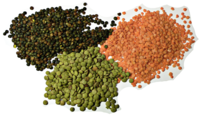
Nematicidal activity of furanoeremophilenes against Meloidogyne incognita and Nacobbus aberrans.
Sign Up to like & getrecommendations! Published in 2022 at "Pest management science"
DOI: 10.1002/ps.6888
Abstract: BACKGROUND While searching for novel small molecules for new organic pesticide agents against plant-parasitic nematodes, we found that the hexane extract from the roots of Senecio sinuatos and its main secondary metabolite, 3β-angeloyloxy-6β-hydroxyfuranoeremophil-1(10)-ene (1), possess… read more here.
Keywords: acid; nacobbus aberrans; activity; meloidogyne incognita ... See more keywords

Nematicidal activity of Echinacea species on the root-knot nematode Meloidogyne incognita
Sign Up to like & getrecommendations! Published in 2020 at "Journal of Pest Science"
DOI: 10.1007/s10340-020-01232-8
Abstract: Echinacea species are reported for a large content of bioactive compounds, but their effects on phytoparasitic nematodes are still unknown. This study comparatively investigated the in vitro activity of chemically characterized extracts from E. angustifolia,… read more here.
Keywords: root knot; meloidogyne incognita; echinacea species; nematode meloidogyne ... See more keywords

Fluopimomide effectively controls Meloidogyne incognita and shows a growth promotion effect in cucumber
Sign Up to like & getrecommendations! Published in 2020 at "Journal of Pest Science"
DOI: 10.1007/s10340-020-01247-1
Abstract: The southern root-knot nematode (Meloidogyne incognita) is one of the most devastating threats to cucumber production in China. The ban of methyl bromide and restricted use of other fumigants and high-toxicity of non-fumigant nematicides increases… read more here.
Keywords: cucumber; meloidogyne incognita; effect; non fumigant ... See more keywords

PIN1 auxin efflux carrier absence in Meloidogyne incognita-induced root-knots of tomato plants
Sign Up to like & getrecommendations! Published in 2021 at "European Journal of Plant Pathology"
DOI: 10.1007/s10658-021-02360-2
Abstract: The nematode species Meloidogyne incognita infects a large variety of cultivated crops and is one of nature’s most notorious pests. One cultivated plant which is prone to M. incognita infestation is the tomato. Knowing that… read more here.
Keywords: meloidogyne incognita; auxin efflux; tomato; tomato plants ... See more keywords

Transcriptomic changes in sweetpotato peroxidases in response to infection with the root-knot nematode Meloidogyne incognita
Sign Up to like & getrecommendations! Published in 2019 at "Molecular Biology Reports"
DOI: 10.1007/s11033-019-04911-7
Abstract: A previous transcriptomic analysis of the roots of susceptible and resistant cultivars of sweetpotato (Ipomoea batatas) identified genes that were likely to contribute to protection against infection with the root-knot nematode Meloidogyne incognita. The current… read more here.
Keywords: root knot; meloidogyne incognita; infection; nematode meloidogyne ... See more keywords

Potential of vermicompost extract in enhancing the biomass and bioactive components along with mitigation of Meloidogyne incognita-induced stress in tomato
Sign Up to like & getrecommendations! Published in 2022 at "Environmental Science and Pollution Research"
DOI: 10.1007/s11356-022-19757-z
Abstract: Increasing inorganic fertilizer and pesticide use has been linked to increased health risks for humans and cattle, as well as substantial water and soil contamination. In recent years, vermicomposting has shown to be a viable… read more here.
Keywords: meloidogyne incognita; vermicompost extract; vce; growth ... See more keywords

Volatile molecules of Fusarium oxysporum strain 21 are retained in water and control Meloidogyne incognita
Sign Up to like & getrecommendations! Published in 2017 at "Biological Control"
DOI: 10.1016/j.biocontrol.2017.06.004
Abstract: Abstract Dissolution in water of volatile organic compounds (VOCs) emitted by microorganisms may explain, in part, the distribution of VOCs throughout the soil, and thus the process of exposure of plant-parasitic nematodes (PPN) to these… read more here.
Keywords: fusarium oxysporum; oxysporum strain; meloidogyne incognita; water ... See more keywords

Biocontrol of Meloidogyne incognita by Metarhizium guizhouense and its protease
Sign Up to like & getrecommendations! Published in 2018 at "Biological Control"
DOI: 10.1016/j.biocontrol.2018.08.005
Abstract: Abstract Crude extracts of the fungus Metarhizium guizhouense PSUM02 grown on protein- enriched medium showed high proteolytic activity and produced one main protein indicated as fungal protease with 33 kDa molecular mass. The protease activity had… read more here.
Keywords: meloidogyne incognita; metarhizium guizhouense; protease; metarhizium ... See more keywords

Multifunctional efficacy of the nodule endophyte Pseudomonas fragi in stimulating tomato immune response against Meloidogyne incognita
Sign Up to like & getrecommendations! Published in 2021 at "Biological Control"
DOI: 10.1016/j.biocontrol.2021.104773
Abstract: Abstract Root-knot nematodes severely affect the growth and productivity of agricultural plants in the world. Conversely, endophytic bacteria can be used to prevent plant diseases and increase crop yield. The nodule endophytic bacterium Pseudomonas fragi… read more here.
Keywords: fragi sneb1990; fragi; meloidogyne incognita; pseudomonas fragi ... See more keywords

Volatile organic molecules from Fusarium oxysporum strain 21 with nematicidal activity against Meloidogyne incognita
Sign Up to like & getrecommendations! Published in 2018 at "Crop Protection"
DOI: 10.1016/j.cropro.2017.12.022
Abstract: Abstract Volatile organic compounds (VOCs) produced by microorganisms are potential alternatives for the development of new nematicides. In a previous study, we identified VOCs produced by Fusarium oxysporum strain 21 (F.o–21). In this study, we… read more here.
Keywords: fusarium oxysporum; oxysporum strain; volatile organic; meloidogyne incognita ... See more keywords

Expression and evolutionary analyses of three acetylcholinesterase genes (Mi-ace-1, Mi-ace-2, Mi-ace-3) in the root-knot nematode Meloidogyne incognita.
Sign Up to like & getrecommendations! Published in 2017 at "Experimental parasitology"
DOI: 10.1016/j.exppara.2017.01.008
Abstract: The full cDNA of Mi-ace-3 encoding an acetylcholinesterase (AChE) in Meloidogyne incognita was cloned and characterized. Mi-ace-3 had an open reading frame of 1875 bp encoding 624 amino acid residues. Key residues essential to AChE… read more here.
Keywords: ace ace; acetylcholinesterase; meloidogyne incognita; ace ... See more keywords